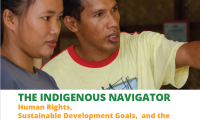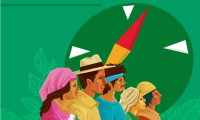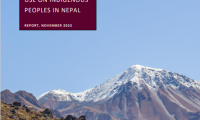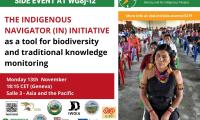Submission to the Expert Mechanism on the Rights of Indigenous Peoples (EMRIP):

Establishing monitoring mechanisms at the national and regional level for implementation of the UN Declaration on the rights of Indigenous Peoples
This written statement is submitted to the Expert Mechanism on the Rights of Indigenous Peoples in response to the call for submission on: “Establishing monitoring mechanisms at the national and regional level for implementation of the UN Declaration on the rights of Indigenous Peoples.”
Context:
15 years after the adoption of The United Nations Declaration on the Rights of Indigenous Peoples (UNDRIP), the reality is that there is a wide implementation gap between what the UNDRIP guarantees and how States actually implement the rights enshrined in the declaration they have signed. In 2017, 10 years after adoption the UN Special Rapporteur on the Rights of Indigenous Peoples[1] and the EMRIP[2] issued key, detailed reports on the realisation and implementation (or lack thereof) of the UNDRIP. From 2017 to 2023, the events unfolding over these years have demonstrated limited progress in the realisation and implementation of the UNDRIP. Further, the last few years clearly demonstrate that, without the full and effective participation of indigenous peoples in decision making at all levels, implementation of the UNDRIP will be impossible.
Indigenous Peoples globally continue to suffer human rights violations by States and private enterprises, who, at times, blatantly ignore the international instrument with explicit laws and court decisions that deny the rights of Indigenous Peoples, or at other times, simply pay lip service to Indigenous Peoples, their rights and the UNDRIP. Further, international financial institutions (IFIs) such as the International Finance Corporation (IFC) and the European Investment Bank (EIB) may also commit to business responsibilities through social and environmental performance standards, which in some part align with the UNDRIP.[3] However, these instruments are no panacea. The tenth anniversary of the UN Guiding Principles for Business and Human Rights for example, saw reporting of a significant implementation gap in regard to respect of Indigenous Peoples’ Rights.[4]
At national level, the effective implementation of the rights of indigenous peoples requires states to develop ambitious reform programs, including legal and political reforms, and specific measures to ensure that indigenous peoples’ rights are protected, respected and fulfilled. As stated by the former UN Special Rapporteur on the rights of indigenous peoples Vicky Tauli-Corpuz, “Implementation of UNDRIP should be measured against these requirements and not based on rhetorical claims of compliance or isolated measures”.
In many cases in States’ ongoing efforts to implement human rights commitments through programs, budget allocations, etc. Indigenous Peoples are still not recognised or well represented. Lack of recognition of Indigenous Peoples continues by national governments – whether by referring to them as ethnic minorities or by claiming that all peoples within the country are Indigenous and thus do not need the special protections provided in the UNDRIP. Further, if national policies are even available, they are often not properly implemented, while in some countries national policies are in direct contradiction with international human rights obligations, including the UNDRIP and ILO Convention No. 169. Where there is legal recognition, these rights are often ignored, or the rulings by the juridical system are not implemented.[5]
It is clear, that despite advances in technology, monitoring and decades of advocacy and repeated recommendations from across the UN System, including over 130 specific recommendations from the UN Permanent Forum on Indigenous Issues, calling for states to disaggregate data on the Indigenous Peoples, there is still a significant data gap in regard to the unique socioeconomic and political circumstances, experienced marginalisation, discrimination and lack of progress on implementation of the UNDRIP. As a result, Indigenous Peoples are left behind, and left out from policy and program developments in many countries.
Despite this, Indigenous Peoples, their local, national and regional organizations, as well as international civil society organizations continue to work together and use everything at their disposal to monitor how the UNDRIP is being implemented, or not, to ensure that the fight to ensure the creation and adoption of the declaration continues to be significant.
The Indigenous Navigator: Data by and for Indigenous Peoples
The Indigenous Navigator is an Indigenous Peoples-led community-based monitoring tool toward the implementation of the UNDRIP, core human rights obligations, essential aspects of the Sustainable Development Goals, as well as the outcomes of the World Conference on Indigenous Peoples. It is a comprehensive tool that enables systematic monitoring of all major provisions of the UNDRIP. It was launched in 2014, not only, to collect data by and for Indigenous Peoples, but also to be able to assess whether, and how, the UNDRIP, and human rights obligations, are being implemented and what real changes, if any, are being made at national and community level. As of 2022, the Indigenous Navigator is being used in 28 countries.[6] The tool is available online, and accessible to indigenous organizations and human rights actors wishing to systematically monitor the implementation of the provisions under the UNDRIP.
The Indigenous Navigator generates data at the national and community levels through three types of human rights indicators: structural, process and outcome indicators. Structural indicators reflect the legal and policy framework of a given country. Process indicators measure the States’ ongoing efforts to implement human rights commitments through programs, budget allocations and other strategies. Outcome indicators capture the actual enjoyment of human rights by Indigenous Peoples in their everyday lives. The Indigenous Navigator is organised in two surveys, national and community, covering 12 thematic domains that address issues relevant for Indigenous Peoples. It is critical to emphasise that those indicators and surveys were developed by Indigenous Peoples. This process and practice should serve as a leading example of a best practice in the monitoring of the implementation of the rights of Indigenous Peoples, and particularly the UNDRIP. This is relevant especially in the light of specific recommendation issued by the UNPFII during its 16th session in 2017 that “encourage[d] collaboration and contributions from Governments, the agencies of the United Nations system, indigenous peoples and civil society organizations to the Indigenous Navigator framework and other tools in order to strengthen community-based monitoring of global commitments made under the Declaration, the World Conference and the Sustainable Development Goals.”[7]
The data is collected by Indigenous communities. These multiple levels of data generation and management allow for producing critical documentation that drives forward advocacy and for developing monitoring frameworks to better understand and recognise the implementation gaps in relation to Indigenous Peoples’ rights, in line with international human rights law and obligations. Further, the data guides project design for Indigenous communities and organisations.
The Indigenous Navigator also focuses on the role of data at the local level and how it serves to empower Indigenous communities to claim the full realisation and implementation of their rights, through for example, environmental monitoring by communities or determining their own locally and culturally appropriate well-being indicators.
Challenges at Local and National level and what the data shows:
|
Figure 1: For the 13 national surveys completed and published, only Bolivia scores above 50% in the implementation of structural and process indicators related to Indigenous Peoples' rights and the UNDRIP. |
Despite some encouraging national achievements, the country reports and data produced by the Indigenous Navigator[8] and reflected in the subsequent editions of the Indigenous World (2017-2022)[9] reiterate that the main challenges faced by indigenous peoples continue to be related to the non-recognition and implementation of their collective rights to lands, territories and resources, their access to justice, lack of consultation and consent, and the gross violations of their fundamental human rights.
Figure 2: When disaggregated by domain, each national level submission shows the varied responses and performance in regard to structural and process indicators in implementation of the UNDRIP across the 12 thematic domains. Note: while some domains receive a full score of 100%, it must be noted that this does not equate with a full realisation of the rights secured under that domain, but only those captured by the Indigenous Navigator’s methodology and indicators.
In addition, the failure of states to consult and cooperate in good faith with indigenous peoples before adopting and implementing legislative or administrative measures that may affect their lives and futures continues unabated throughout the indigenous world.
Role of NHRIs
Thanks to their constitutional and/or legislative mandates to promote and protect human rights, National Human Rights Institutions (NHRIs) are uniquely positioned to monitor implementation of the UNDRIP by States. Their role in this regard, including complaint handling, advocacy, review as well as formulation of laws and, most of all, monitoring their State’s human rights performance, has been clearly outlined by several United Nations bodies and mechanisms, including the Human Rights Council,[10] the United Nations Permanent Forum on Indigenous Issues,[11] the Expert Mechanism on the Rights of Indigenous Peoples[12]and the Special Rapporteur on the rights of indigenous peoples.[13] Moreover, the collection and analysis of data provided by NHRIs is essential in providing technical guidance to governments on drafting, adoption and implementation of laws and policies. This is equally relevant in the context of monitoring of the UNDRIP.
According to the principle of human rights-based approach, Indigenous peoples’ organizations should be involved at every stage of any process that may impact their lives, from design and development through to implementation and monitoring. As noted in the Manual for National Human Rights Institutions[14] published by the Office of the High Commissioner for Human Rights (OHCHR) and the Asia Pacific Forum (APF), several NHRIs in Latin America have established a Permanent Bureau on Indigenous Issues to bring together indigenous organizations and NHRI in order to define and agree on priorities. It was reported that the initiative has helped facilitate joint work and strategies to advance the human rights of Indigenous Peoples as well as build trust between the different stakeholders.[15]
[1] Report of the Special Rapporteur of the Human Rights Council on the rights of indigenous peoples, A/72/186
[2] Ten-years of the implementation of the United Nations Declaration on the rights of Indigenous Peoples: good practices and lessons learned (2017), Indigenous Peoples rights with respect to: Recognition, reparations, and reconciliation (2019), Indigenous Peoples and the right to self-determination (2021).
[3] EIB (2018), Environmental and Social Handbook, European Investment Bank; IFC (2012), Performance Standard 7: Indigenous Peoples.
[4] José Aylwin and Johannes Rohr, The UN Guiding Principles on Business & Human Rights and Indigenous Peoples: Progress Achieved, the Implementation Gap and Challenges for the Next Decade (Copenhagen: IWGIA, 2021).
[5] IWGIA. 2022. “Green colonialism, wind energy and climate justice in Sápmi” https://www.iwgia.org/en/news/4956-green-colonialism,-wind-energy-and-climate-justice-in-s%C3%A1pmi.html ; Vars, Laila Susanne. (2022). “Sápmi” in Mamo, D. (Ed.), The Indigenous World 2021 (36th Edition, pp. 500-508), Copenhagen, Denmark: International Work Group for Indigenous Affairs (IWGIA). https://iwgia.org/en/sapmi/4679-iw-2022-sapmi.html; Supreme Court of Norway. “Licences for wind power development on Fosen ruled invalid as the construction violates Sami reindeer herders' right to enjoy their own culture.” Supreme Court judgment 11 October 2021, HR-2021-1975-S (case no. 20-143891SIV-HRET, case no. 20-143892-SIV-HRET and case no. 20-143893SIV-HRET). https://www.domstol.no/globalassets/upload/hret/avgjorelser/2021/oktober-2021/hr-2021-1975-s.pdf
[6] Argentina, Bangladesh, Bolivia, Brazil, Cambodia, Cameroon, Chile, Colombia, Ecuador, Finland, Guyana, India, Indonesia, Japan, Kenya, Malaysia, Mexico, Nepal, Norway, Paraguay, Peru, Philippines, South Africa, Suriname, Sweden, Thailand, Uganda, and Tanzania
[7] E/2017/43-E/C.19/2017/11, para. 29.
[8] Indigenous Navigator. National surveys. Bolivia, Peru, Tanzania, Cameroon, Nepal, Philippines, Bangladesh, Kenya, Colombia, Suriname, Norway, Sweden, Finland. https://indigenousnavigator.org/data-explorer/2
[9] IWGIA. 2017, 2018, 2019, 2020, 2021, 2022). The Indigenous World. Copenhagen, Denmark: International Work Group for Indigenous Affairs (IWGIA).
[10] Human Rights Council resolution 15/7, para. 12.
[11] E/2010/43-E/C.19/2010/15, paras. 53 and 93.
[12] A/HRC/12/32, p. 5; A/HRC/15/36, pp. 3-4; and A/HRC/18/43, p. 6.
[13] A/64/338, para. 7.
[14] GANHRI. 2013. United Nations Declaration on the Rights of Indigenous Peoples Manual https://www.ohchr.org/sites/default/files/Documents/Countries/NHRI/GANHRI/Declaration_Indigenous_Peoples_Manual_NHRIs.pdf p. 66.
[15] Ibid
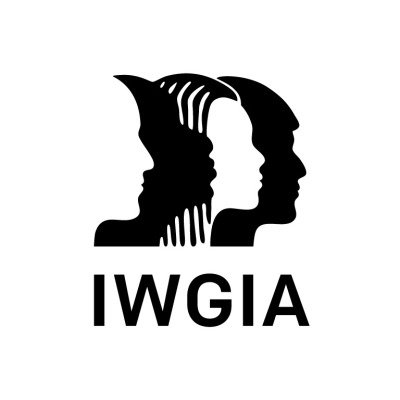
Contact

